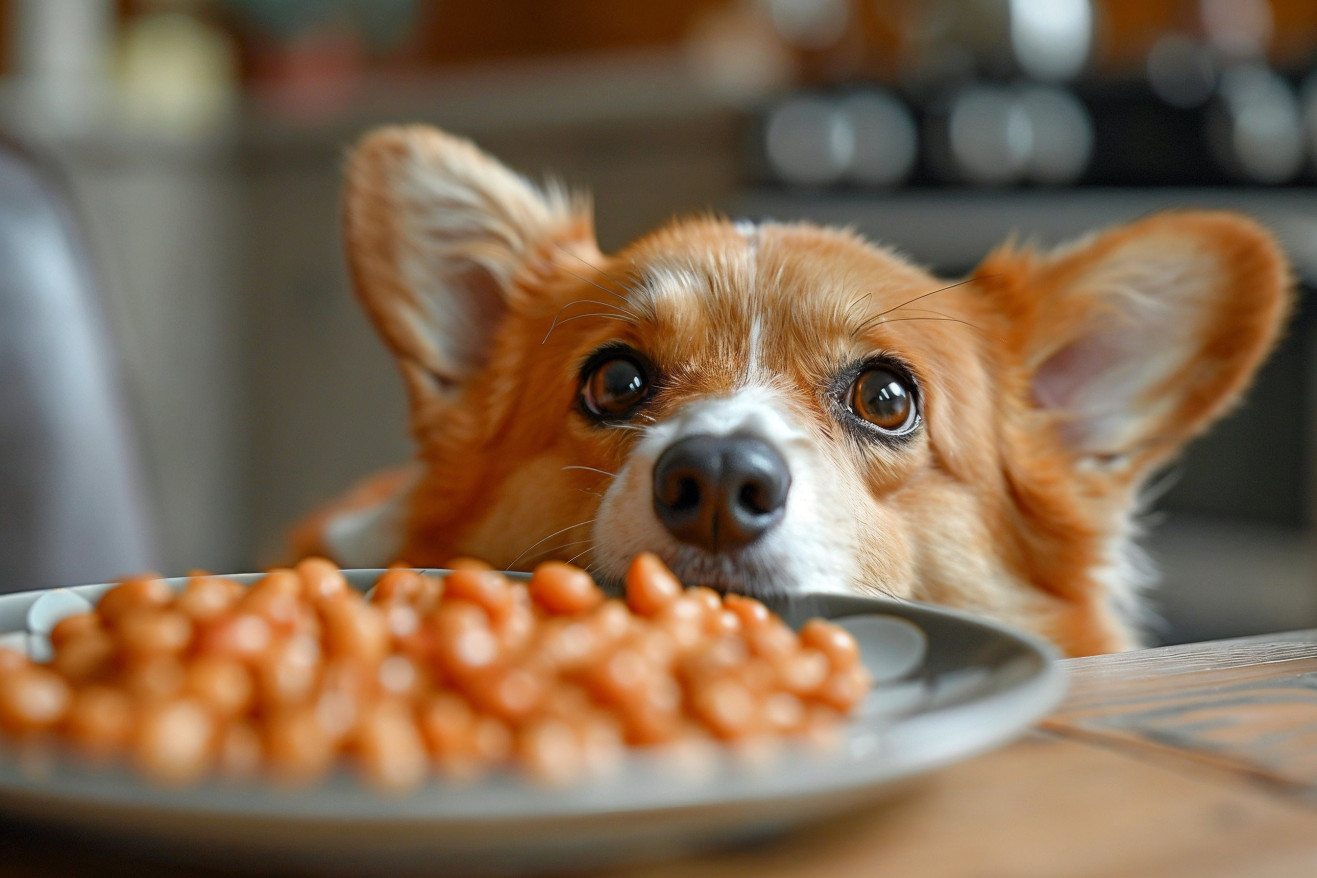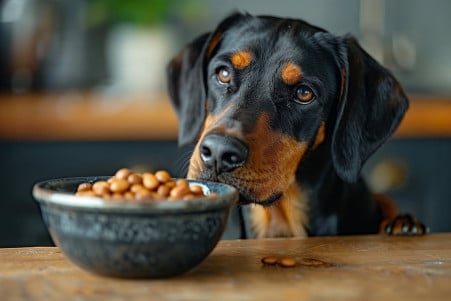Can Dogs Eat Pinto Beans? How Much Is Safe to Feed Your Dog?
11 March 2024 • Updated 10 March 2024

Pinto beans are a dietary staple for many people, but can you share them with your dog? The answer is yes, you can feed your dog pinto beans in moderation. They are a good source of protein and fiber, which can be good for dogs, especially when it comes to helping them manage their weight.
However, pinto beans should be cooked plainly, without any salt or other seasonings, and should only be given to your dog as an occasional treat, not as a substitute for their regular meals.
This article will take a deep dive into the intersection of dog nutrition and veterinary science to help you understand how pinto beans can fit into your dog’s diet. We’ll look at research on the digestibility and nutritional value of legumes for dogs, as well as potential downsides and the best ways to prepare pinto beans to ensure they are safe for your dog to eat.
Our aim is to give you a science-based understanding that will help you decide whether or not to add pinto beans to your dog’s eating plan.
Can dogs eat pinto beans?
Pinto Beans: A Healthy Treat for Your Dog
In addition to being a healthy addition to a human diet, pinto beans can offer a number of health benefits to dogs.
Pinto beans are high in B vitamins, iron, and potassium, as well as antioxidants, which are important for good health and can help protect against certain diseases.
According to DogTime, pinto beans are also a good source of protein and fiber, both of which are important components of a dog’s diet. Protein is necessary for maintaining muscle mass and other bodily functions, while fiber is important for maintaining a healthy digestive system and regulating weight. As a result, pinto beans can be a great treat for dogs, especially those that are on a diet.
That said, it’s important to make sure that your dog’s diet is still well-rounded.
To ensure that pinto beans are a good addition to your dog’s diet, Rover.com recommends feeding them in moderation so that they can be added without displacing other important nutrients.
In general, a small amount, such as a tablespoon or two, can be added to a dog’s regular meals without exceeding 10% of their daily caloric intake. However, it’s always best to check with your vet before adding pinto beans or any other new food to your dog’s diet or making any other major changes, as individual nutritional needs can vary greatly.
How Dogs Digest Legumes
While dogs are primarily meat-eaters, they have adapted to eat a variety of foods, including the plant-based proteins and fibers found in legumes like pinto beans. Like humans, dogs can digest and absorb nutrients from plant-based sources, but they do so less efficiently than they do animal proteins.
A study cited by PMC notes that legumes, with their varied macronutrient content and slowly fermentable fiber, can have a positive impact on a dog’s gut microbiome, especially in the distal colon.
When researchers evaluated the fermentative profile of legumes with canine fecal inoculum, they discovered that legumes like pinto beans produced short-chain fatty acids and gases, which are markers of fermentation and digestion in the canine gut. These fermentation properties suggest that while dogs can digest pinto beans, the process is slow, and the addition of legumes to a dog’s diet should be carefully managed to ensure that it doesn’t cause any adverse effects.
These results suggest that dogs can eat pinto beans, but they should be introduced to the diet slowly and carefully to ensure that the dog can tolerate them. This will help make sure that dogs can benefit from the nutritional value of legumes without any negative effects on their digestive system.
Balancing the Bowl: Nutritional Requirements of Dogs
Knowing what dogs need in their diet is important for making sure that they live long and healthy lives. Since dogs are omnivores, they need a combination of water, proteins, fats, carbohydrates, minerals, and vitamins to meet their dietary needs. These nutrients are necessary for a variety of bodily functions, including maintaining muscles and creating energy.
VCA Animal Hospitals explains that while proteins are important for energy, they are also needed for tissue repair and growth. Fiber is another important part of a dog’s diet, helping to keep their digestive system healthy and aiding in weight control.
Pinto beans can help ensure that dogs get the right mix of these nutrients, as they contain protein, fiber, and a variety of micronutrients.
However, pinto beans need to be added to a dog’s diet in a way that meets the standards set by the Association of American Feed Control Officials and the recommendations set by veterinarians, as explained by PetMD. This means that pinto beans should be added to a dog’s diet in a way that supplements the nutrients dogs get from their regular food rather than replacing them.
The fact that dogs can eat a diet that includes legumes like pinto beans is evidence of the way that they have evolved alongside humans. However, while dogs can eat a variety of foods, the key is to ensure that the foods they consume are high quality, easily digestible, and balanced. By doing this, dog owners can ensure that their pets receive a diet that is both diverse and nutritious.
Navigating the Risks: Canine Allergies and Bean Toxicities
While pinto beans can be a nutritious treat for many dogs, it’s important for pet parents to understand the risks of food allergies. PetMD explains that proteins are the most common cause of food allergies in dogs, and the resulting allergic reactions can cause itching, swelling, and digestive issues.
Legumes, including pinto beans, are less common allergens than proteins like chicken or beef, but the Clinical Nutrition Team at Cummings School of Veterinary Medicine says that dogs can be allergic to any protein. This makes it important to watch your dog for signs of an allergic reaction after you introduce pinto beans into their diet.
Toxicity is another concern, especially when it comes to the additives that are often found in canned legumes. Redbarn Pet Products points out that high levels of sodium and seasonings like onion or garlic powder can be toxic to dogs, with symptoms that include increased thirst and anemia. Making pinto beans for your dog at home is the best way to avoid any potentially toxic additives.
If you think your dog is having an allergic reaction or is experiencing toxicity, contact your vet right away. It’s important to pay attention to your dog’s response to new foods and to take a cautious approach to introducing them to ensure their safety.
How to Make Pinto Beans for Dogs
To make sure that pinto beans are safe and healthy for your dog to eat, there are a few steps you should follow. First, you should soak the beans overnight to help soften them and make them easier to digest, according to Recipes.net. After soaking, boil the beans in fresh water for one to one and a half hours until they are soft, and then let them cool to room temperature before serving.
Do not add any salt, spices, or seasoning to the beans when you’re making them for dogs, according to PetMD. These can be dangerous to your dog’s health and lead to issues with sodium or even toxicity. The general consensus, including the American Kennel Club’s recommendation, is to use dried beans instead of canned beans, which often have preservatives and high levels of sodium.
In terms of serving size, PetMD recommends a small amount for small dogs and up to half a cup for large dogs. When you first start feeding your dog pinto beans, make sure to do so in moderation and over time so that you can monitor your dog’s reaction and make sure that they don’t have any issues with the beans.
If you follow these steps, you can make sure that you’re feeding your dog this nutritious legume in a way that is safe and healthy.
The Takeaway on Dogs Eating Pinto Beans
Overall, pinto beans can be a healthy part of your dog’s diet if they are fed in moderation and prepared properly. Pinto beans are a good source of essential nutrients like B vitamins, protein, and fiber, which can help with everything from muscle development to digestive health.
However, it’s important to remember that when it comes to portion size, less is more in order to avoid any digestive issues and to ensure that your dog is getting a well-rounded diet.
When it comes to preparing pinto beans for your dog, make sure to cook them simply, without any added spices or salt, and introduce them to your dog’s diet slowly. Keep an eye out for any signs of food allergies or sensitivities, and make sure to contact your vet if you have any concerns.
Always talk to your vet before making any changes to your dog’s diet, including adding pinto beans. While pinto beans can be a healthy addition to your dog’s diet, they should never be used as a replacement for a well-balanced meal. Instead, think of pinto beans as one part of a larger whole when it comes to your dog’s diet.


